Punjab State Board PSEB 8th Class Social Science Book Solutions History Chapter 16 The Education and British Rule Textbook Exercise Questions and Answers.
PSEB Solutions for Class 8 Social Science History Chapter 16 The Education and British Rule
SST Guide for Class 8 PSEB The Education and British Rule Textbook Questions and Answers
I. Answer the following questions :
Question 1.
What do you mean by the new educational system?
Answer:
Education of Western literature in the English language was given in new education system. That’s why new schools, colleges and universities were opened. Later on, technical education was also emphasized.
Question 2.
What do you mean by Wood’s Despatch?
Answer:
Important recommendations were given by Chairman of Board of Control Charles Wood in 1854 A.D. for the development of education. These recommendations are known as Wood’s Despatch.
Question 3.
When the title of ‘Sir’ was conferred to Sir Sayyed Ahmad Khan? When did he die?
Answer:
Sir Sayyed Ahmad Khan was conferred the title of ‘Sir’ in 1898 A.D. He died in the same year i.e. in 1898 A.D.
Question 4.
In which languages the Raja Ram Mohan Roy was expert?
Answer:
Raja Ram Mohan Roy was an expert in Bengali, Persian, Sanskrit, Urdu, English and Greek languages.
![]()
Question 5.
Which book was written by Ishwar Chander Vidyasagar?
Answer:
Ishwar Chander Vidyasagar wrote a book called ‘Premier Varna Parichaya’ in Bengali language.
Question 6.
Write down the objectives of the new educational system.
Answer:
New educational system was started due to following objectives :
- Educated Indians were required by the British to run their administration.
- Those educated people were required who could know English and who could be able to tell them about the problems of the people.
- The British were of the view that educated Indians could be easily converted into Christians.
Question 7.
What were the recommendations of Hunter Commission about education?
Answer:
The Hunter Commission was appointed in 1882 A.D. Its education related recommendations are given below :
- Private schools should be given enough grants.
- Reforms should be brought in secondary schools.
- Special arrangements of women education should be made.
- Students should be given physical and moral education.
- There should not be much government interference in schools and colleges.
Question 8.
Write down the effects of Western Educational System.
Answer:
Following were the impacts of Western Educational System :
- Most of the people remained illiterate due to expensive educational system.
- The British government did not give any emphasis on higher education. As a result there was no development in Indian languages with which link of Indians with higher education was broken.
- Western-educated Indians got the opportunity to read foreign history.
- Spread of Western Education helped in eradication of superstitions from India.
- Western education aroused national consciousness among Indians. In the end they were able to remove the foreign rule from the country.
![]()
Question 9.
Explain the growth of Modern Education System.
Answer:
The British laid the foundation of Modern Education System in India. The English East India Company opened a school, Saint Mary Charity School, at Madras in 1715 A.D. Lord Warren Hastings established Calcutta Madrasa in 1718 A.D. Muslim students of rich families took education over here. One Sanskrit College was started at Benaras due to the efforts of Jonathan Tunckon later on. It was a centre of Hindu education. After this, the story of development of education starts in 1813 A.D.
I. Development of Education from 1813 A.D. till 1854 A.D. The British government planned to spend one lakh rupees every year on the development of education through Charter Act of 1813 A.D. But it didn’t spend this amount due to lack to any clear policy. A committee was made in 1823 A.D. to give recommendations on education policy. But there were some differences among the members of this committee. Some of its members were in favour of giving Western education through the medium of English language. On contrary to it, some members wanted to make local languages, like Sanskrit, Arabian, Persian etc., as medium of education. Lord MacaulejHbecame the President of Education Committee in 1835 A.D. He gave his decision in favour of Western education. Raja Ram Mohan Roy also gave stress on adopting Western education.
Wood’s Despatch. A committee was constituted in 1854 A.D. under the chairmanship of Charles Wood for the spread of Modern Education in India. The recommendations of Charles Wood were known as Wood’s Despatch.
It gave the following recommendations for bringing educational reforms :
- An educational department should be established in every province of the country.
- Universities should be established in major cities such as Calcutta, Bombay, Madras, etc.
- One government school should be opened in every district.
- The arrangement should be made for training of teachers so that the level of education could be raised.
- Schools should be opened for women.
On the basis of recommendations of Charles Wood, universities were set up at Calcutta, Bombay and Madras in 1857 A.D. Medical Colleges were also opened in these cities in the same year. Government College of Lahore was established in 1864 A.D.
II. Development of Education after 1854 A.D.
Hunter Commission. Hunter Commission was appointed in 1882 A.D. Its education-related recommendations are given below :
- Private schools should be given enough grants.
- Secondary schools should be improved.
- Special arrangements of women education should be made.
- Students should be given physical as well as moral education.
- Not much government interference should be there in schools and colleges.
Government accepted the recommendations of Hunter Commission which became the base of Modern Educational System.
Indian University Act 1904 A.D. Lord Curzon passed an Act called ‘Indian University Act’ in 1904 A.D. Government interference in universities was increased due to this Act. That’s why this act was greatly opposed by the Nationalists.
Sadller Committee. Government appointed Sadller Committee in 1917 A.D.
This committee gave following recommendations for the development of education :
- Medium of education at school level, should be Indian languages and later on it should be English language.
- The examination system should be improved.
- Government control over universities should be reduced.
- Special emphasis should be given on Technical Education.
- The vice-Chancellor should be appointed in every university.
Hurtog Committee 1928. Hurtog Committee was appointed in 1928 A.D. for spread and bringing reforms in educational sector.
This committee gave following recommendations :
- Primary education should be made compulsory.
- Salary of teachers should be increased.
- Extra expenditure on education should not be done.
Basic Education 1937 A.D. Mahatma Gandhi gave suggestions in 1937 A.D. for starting Basic Education. He was of the view that free and compulsory education should be given to the children up to the age of 14 years. They should also be given technical education.
Seargent Scheme. Seargent gave certain recommendations in 1943 A.D. for the development of education.
The following were the given recommendations :
- Education should be given in Nursery Schools before Primary education.
- Free education should be given to students of the age of 6-15 years.
- Adult education should be given.
- Limited students should be admitted in colleges.
![]()
Question 10.
Write down in brief about the Maharaja Sayaji Rao University in Baroda.
Answer:
Baroda is an important city of Gujarat State. This city is famous for Maharaja Sayaji Rao University. This university was founded by Maharaja Sayaji Rao III in 1948 A.D.
Works done by Maharaja. Maharaja Sayaji Rao himself was a great scholar. He gave a great contribution in the field of education. He also did few important works in social and economic sectors.
- He severely criticized the prevailing social evils such as casteism and untouchability.
- He opened many schools, libraries and hospitals with the help of his state.
- He opened a college at Baroda in 1881 A.D. which later on became a university. Many foreigner students also used to visit this university to take education.
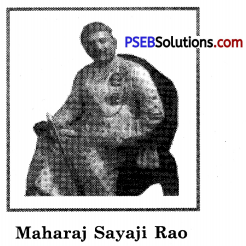
Around 20 Public Schools and more than 100 Private Schools are associated with Maharaja Sayaji Rao University of Baroda. Education in this university is given only in the English medium. Around 3000 Indian and foreigner students take education in this university.
Question 11.
Explain the contribution of the following different intellectuals in the field of education.
(a) Raja Ram Mohan Roy
Answer:
Raja Ram Mohan Roy. Raja Ram Mohan Roy was in favour of providing Western Education to Indians. He published newspapers and wrote books on many subjects like-Geography, Astronomy, Grammar, Algebra etc. in Bengali language. He opened one English school and one Vedant College at Calcutta on his own expenses.
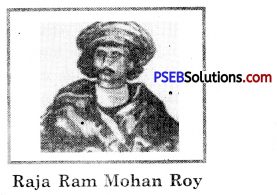
(b) Swami Dayanand Sarasvati
Answer:
Swami Dayanand Sarasvati. Swami Dayanand Sarasvati was a supporter of not only of Sanskrit and Vedic education but also of Western education. He founded many schools, colleges and Gurukuls in different parts of the country especially Punjab and Uttar Pradesh. In 1886 A.D., one Dayanand Anglo Vedic School was opened at Lahore after his death. The students were given the education of Hindu literature, Sanskrit language and Vedas. Later on D.A.V. schools, colleges were also opened at Hoshiarpur, Jalandhar and Kanpur. One Girls University was also opened at Meerut in the memory of Swami Dayanand.
(c) Swami Vivekanand
Answer:
Swami Vivekanand. The Rama Krishna Mission was founded by Swami Vivekananda. This organization opened many schools, colleges, libraries and hospitals for social welfare. _ j Swami Ji also propagated Indian Culture in America and Europe.
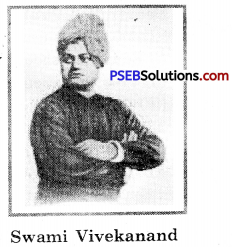
(d) Ishwar Chander Vidyasagar.
Answer:
Ishwar Chandra Vidyasagar, Ishwar Chandra Vidyasagar was a famous scholar. He wrote a book in Bengali language called ‘Premier Varna Parichaya’. This book made easy the art of learning language. Ishwar Chandra Vidyasagar was a principal of Sanskrit College. He introduced a new method of learning Sanskrit. He also gave a great contribution in the field of education of girls.
II. Fill in the blanks :
Question 1.
Sir Sayyid Ahmad Khan established Muslim Anglo-Oriental _________ in Aligarh.
Answer:
School
Question 2.
In 1888 A.D. he conferred the title of ________
Answer:
Sir
![]()
Question 3.
During the time of Swami Dyanand Saraswati a women college was established in ________
Answer:
Meerut.
III. Match the words :
Question 1.
| A | B |
| 1. Raja Ram Mohan Roy | (iii) Persian, Sanskrit,Urdu, English and Greek language. |
| 2. Ishwar Chandar Vidyasagar | (i) Wrote a book in Bengali language named ‘Premier Varna Prichaya’ |
| 3. Swami Vivekanand | (ii) established Rama Krishan Mission was well versed in Bengali, |
Answer:
| A | B |
| 1. Raja Ram Mohan Roy | (iii) Persian, Sanskrit, Urdu, English and Greek language. |
| 2. Ishwar Chandra Vidyasagar | (i) Wrote a book in the Bengali language named ‘Premier Varna Prichaya’ |
| 3. Swami Vivekanand | (ii) established Rama Krishan Mission was well versed in Bengali, |
IV. Things To Do :
Question 1.
Students collect more information about Mahatma Gandhi ji.
Answer:
Do it yourself with the help of your teacher and text book.
![]()
Question 2.
Students collect more information about Ravinder Nath Tagore.
Answer:
Do it yourself with the help of your teacher and text book.
PSEB 8th Class Social Science Guide The Education and British Rule Important Questions and Answers
Multiple Choice Questions:
Question 1.
Schools in Mosques were called
(a) Maktaba
(b) Mashraba
(c) Hyda
(d) Sanatani.
Answer:
(a) Maktaba.
Question 2.
In which of the following languages, the education w as imparted before the British period?
(a) Urdu
(b) Gurmukhi
(c) Sanskrit
(d) All of these.
Answer:
(d) All of these.
Question 3.
Schools were opened for education in handicrafts and trade and they were called as
(a) Trade school
(b) Mahajan schools
(c) Handicraft schools
(d) Maktaba.
Answer:
(b) Mahajan schools
Question 4.
In language a learning place is called ‘Madarsa’.
(a) Persian
(b) Urdu
(c) Arabian
(d) Greek.
Answer:
(c) Arabian.
![]()
Question 5.
Who established new schools, colleges and universities?
(a) French
(b) British
(c) Portuguese
(d) Dutch.
Answer:
(b) British.
Question 6.
When was the Hunter Commission set up?
(a) 1882 A.D.
(b) 1904 A.D.
(c) 1917 A.D.
(d) 1928 A.D.
Answer:
(a) 1882 A.D.
Question 7.
When was Wood’s Disptach came?
(a) 1851 A.D.
(b) 1852 A.D.
(c) 1853 A.D.
(d) 1854 A.D.
Answer:
(d) 1854 A.D.
Question 8.
When did Sargent Scheme came?
(a) 1943 A.D.
(b) 1954 A.D.
(c) 1944 A.D.
(d) 1845 A.D.
Answer:
(a) 1943 A.D.
Question 9.
Who started Shantiniketan?
(a) Mahatma Gandhi
(b) Rabindra Nath Tagore
(c) Gopal Krishan Gokhala
(d) Lala Lajpat Rai.
Answer:
(b) Rabindra Nath Tagore.
Question 10.
When was Sayaji Rao university established?
(a) 1945 A.D.
(b) 1946 A.D.
(c) 1948 A.D.
(d) 1949 A.D.
Answer:
(c) 1948 A.D.
![]()
Question 11.
This person wrote a book called ‘Satyarath Prakash’ and established Arya Samaj. Name the person.
(a) Dayanand Saraswati
(b) Vivekananda
(c) Jyoti ba Phule
(d) None of these.
Answer:
(a) Dayanand Saraswati
Fill in the Blanks :
Question 1.
Sir Sayyed Ahmed Khan established Mohammden Anglo-Oriental ________ at Aligarh.
Answer:
College
Question 2.
In 1988 A.D. Sayyed Ahmed Khan was given the title of ________
Answer:
Sir
Question 3.
During the time of Swami Dyanand Saraswati, a girls college was established at ________
Answer:
Meerut.
Tick the Right (✓) or Wrong (✗) Answer:
Question 1.
Aligarh Muslim University was founded in 1875 A.D.
Answer:
(✗)
Question 2.
Mahatma Gandhi stressed on vocational education in colleges.
Answer:
(✓)
![]()
Question 3.
Mahatma Gandhi and Rabindra Nath Tagore were against Western education.
Answer:
(✓)
Match the Following :
Question 1.
| A | B |
| 1. Raja Ram Mohan Roy | (i) Arya Samaj |
| 2. Ishwar Chandra Vidyasagar | (ii) Sati Pratha |
| 3. Swami Dayanand Saraswati | (iii) Widow re-marriage |
Answer:
| A | B |
| 1. Raja Ram Mohan Roy | (ii) Sati Pratha |
| 2. Ishwar Chandra Vidyasagar | (iii) Widow re-marriage |
| 3. Swami Dayanand Saraswati | (i) Arya Samaj |
Very Short Answer Type Questions
Question 1.
What were Mahajan Schools in India before the advent of the British?
Answer:
Mahajan Schools were those schools where students were given the education of business and of any art.
Question 2.
Who was Lord Macauley? When did he give his verdict in the favour of Western Education?
Answer:
Lord Macauley as the Chairman of Education Committee. He gave his verdict in favour of Western Education in 1835 A.D.
Question 3.
When were Universities and Medical Colleges opened at Bombay, Calcutta and Madras?
Answer:
In 1857 A.D.
Question 4.
When was the ‘Indian University Act, 1904’ passed? What was its defect?
Answer:
‘Indian University Act, 1904’ was passed in 1904 A.D. Its defect was that it increased government control over universities.
![]()
Question 5.
When and who gave the idea of Basic Education?
Answer:
The idea of Basic education was given by Mahatma Gandhi in 1937 A.D.
Question 6.
With what objective, Raja Ram Mohan Roy took certain steps for the development of education?
Answer:
Raja Ram Mohan Roy took certain steps for the development of education with the objective of eradicating prevailing social evils, wrong customs and superstitions of Indian Society.
Question 7.
In which two main states Swami Dayanand Sarasvati established schools, colleges and Gurukuls?
Answer:
In Uttar Pradesh and Punjab.
Question 8.
In which State Baroda city is situated and for which Educational institution it is famous?
Answer:
Baroda city is situated in Gujarat State. It is mainly famous for Maharaja Sayaji Rao University.
Question 9.
Who founded Rama Krishna Mission? What this institution has done for social welfare?
Answer:
Rama Krishna Mission was founded by Swami Vivekananda. This Institution opened many schools, colleges and libraries for social welfare.
Question 10.
Who was Sir Sayyed Ahmad Khan? Why he started Aligarh movement?
Answer:
Sir Sayyed Ahmad Khan was the first Muslim social reformer. He started Aligarh movement for bringing reforms in Islamic society and religion.
Question 11.
Who was the first Principal of Aligarh Mohammaden Anglo College? In which work he helped Sir Sayyed Ahmad Khan?
Answer:
The First Principal of Aligarh Mohammadan Anglo-Oriental College was Mr. Beck. He helped Sir Sayyed Ahmad Khan in bringing Muslims and the British government closer to each other.
Question 12.
Who was Charles Wood?
Answer:
Charles Wood was the President of Board of Control. He gave certain recommendations on education in India which are called Wood’s Dispatch.
![]()
Question 13.
Who passed Indian Universities law and why?
Answer:
Indian universities law was passed in 1904 A.D. by Lord Curzon with which interference of the government in universities increased.
Question 14.
What was favoured by Swami Dayanand Sarasvati?
Answer:
Swami Dayanand Sarasvati was in favour of imparting Sanskrit, vedic education along with western education.
Question 15.
Who is believed to have begun the English medium of education in India?
Answer:
Charles Wood.
Question 16.
Many universities were opened up at various places on the recommendation of Sir Charles Wood. Name any one place.
Answer:
Bombay, Calcutta etc.
Short Answer Type Questions
Question 1.
What was system of education in India before the advent of the British in India? (P-B. 2006)
Answer:
Before the advent of the British in India, Primary education was given in Mosques, Temples and Gurudwaras.
- Schools of Mosques were known as Maqtab or schools of Temples and Gurudwaras were known as Pathshalas. All these were religious schools because these schools used to teach the religious books of their respective religions. Language was also of their own religion.
- In Maqtab, Urdu, Persian and Arabian languages were used. In Gurudwaras Gurumukhi language and in Temples Hindi and Sanskrit languages were used to teach their respective students. Teachers who gave education were religious leaders.
- Larger schools were there for higher education. These were generally different from religious places. Teachers of these schools were generally scholars.
- The schools, in which Arabian and Persian were taught, were known as Madrassas. Students of all the religions were allowed to take education over here.
- For Higher education of Hindi and Sanskrit, arrangement was there in larger schools like Benaras.
- Special schools were also there in India for training of business or of any art. These were known as Mahajani Schools.
Question 2.
Write a note on Aligarh Movement.
Answer:
Aligarh movement was a Muslim movement. This movement was started by Sir Sayyed Ahmad Khan for arousing consciousness among Muslims. He was of the view that Muslim Society cannot develop until Muslims will not take English education. That’s why he encouraged Muslims to take English education. He founded Mohammadan Anglo- Oriental College at Aligarh in 1875 A.D. This college later on became the famous Aligarh Muslim University. This university contributed in giving modern outlook to its citizens. Sir Sayyed Ahmad Khan was died in 1898 A.D. but the Aligarh University founded by him is still progressing sc lot.
![]()
Question 3.
When was Sadller’s Committee appointed? What were its education related recommendations?
Answer:
Sadller’s Committee was appointed in 1917 A.D. This committee gave following recommendations for the development of education.
- Medium of education should be Indian language at school level and English language at higher level.
- Examination system should be improved.
- The government’s control on universities should bfe reduced.
- Special emphasis should be given on Technical education.
- Vice-Chanceller should be appointed in each university.
Question 4.
What were the education-related recommendations of the Hurtog Committee?
Answer:
Hartog Committee was appointed in 1928 A.D. to spread and reforms in education system. This committee gave the following recommendations :
- Primary education should be made compulsory.
- Salary of teachers should be increased.
- Extra expenditure on education should be reduced.
Long Answer Type Questions
Question 1.
Write a note on Sir Sayyed Ahmad Khan and Aligarh Movement.
Answer:
Sir Sayyed Ahmad Khan was first Muslim social reformer. He started Aligarh movement in 19th century for bringing reforms in Islamic Society and Islam religion.
Important works:
1. He explained concepts of Islam religion to eradicate prevailing social evils and wrong customs among Indian Muslims.
2. He was of the view that development of western education is necessary for bringing consciousness among Muslims. That’s why he motivated Muslims to study Western literature and to eet Western Education. , , ,
3. He founded Mohammadan Anglo-Oriental College at Aligarh in 1875 A.D. Here Muslim students were given Western Education. Later on this college became the centre of activities of Aligarh Movement. This college became Aligarh Muslim University in 1920 A.D.
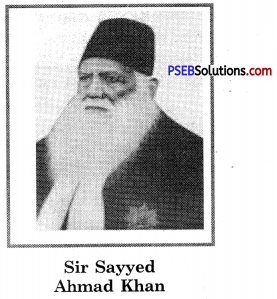
4. Sir Sayyed Ahmad Khan wanted to bring Muslims closer to the British government so that Muslim interests could be protected with the help of the British government.
To achieve this objective, Mr. Beck helped him a lot who was the first Principal of Muhammadan Anglo-Oriental College.
In 1878 A.D., Sir Sayyed Ahmad Khan was made the member of Public Service Commission. He was appointed as the member of Viceroy’s Council in 1882 A.D. He was given the title of ‘Sir’ in 1898 A.D. He died in the same year.
Aligarh Movement. Aligarh Movement was started by Sir Sayyed Ahmad Khan for bringing consciousness among Muslims. It is known as Aligarh Movement because its centre was Aligarh. Leaders of this movement motivated the people to adopt concepts of ‘Quran’ and to eradicate wrong customs from their lives. They also stressed on getting Western Education by the Muslims.
![]()
Question 2.
Write down about the Aligarh Muslim University.
Answer:
Aligarh is a famous city of Uttar TPradesh. Sir Sayyid Ahmad Khan founded Mohammadan Anglo-Oriental College over here in 1875 A.D. His objective was to provide education of western literature and English language to Muslims because Muslims leaders like Sir Sayyid Ahmad Khan and Hidayattiilah Khan were of the view that education of western literature and English language is necessary for the all round development of Muslims. That’s why Mohammadan Anglo-Oriental College was founded and the education given by it was given the name of Aligarh movement. In 1920 A.D., Aligarh Muslim University was founded over here.
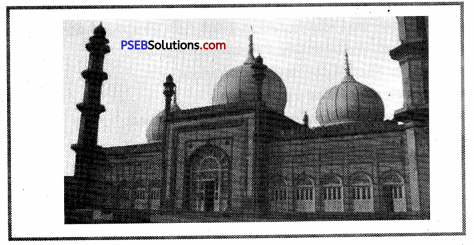
Aligarh University
The first Chancellor of Aligarh University was Sultan Jahan Begum. This University spread with the passage of time. It established many Medical and Engineering colleges. Presently this university has 80 educational departments. Around 30,000 students each year take education in this university.
